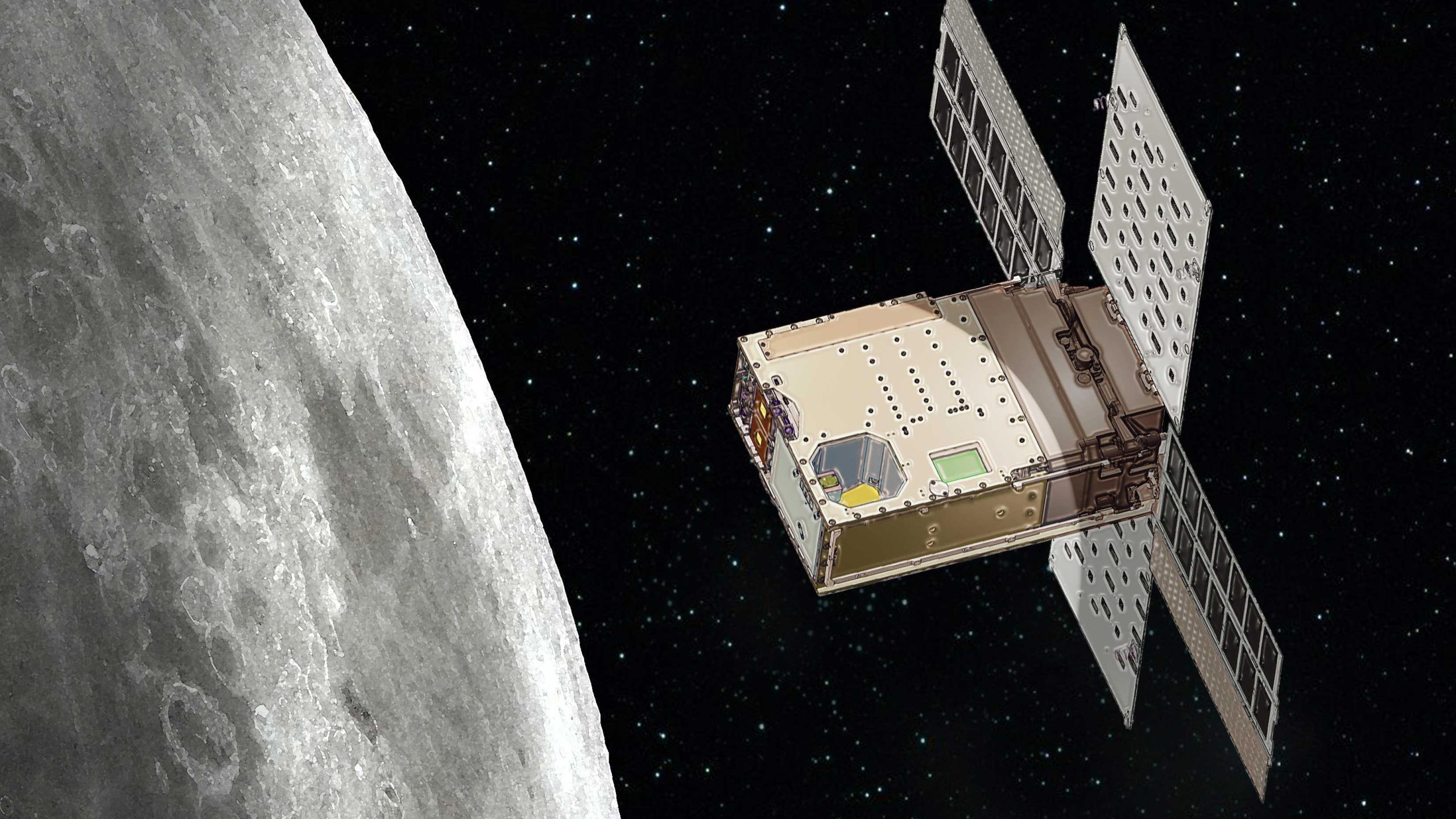يوضح هذا الرسم التوضيحي التوهج القمري لوكالة ناسا فوق القمر. سيكون لمهمة SmallSat أطول مدار ، في نطاق 9 أميال (15 كيلومترًا) فوق القطب الجنوبي للقمر ، للبحث عن الجليد المائي في الحفر المظلمة للقمر. الائتمان: ناسا
تم إطلاق Lunar Lantern في نوفمبر ، وهي مهمة صغيرة عبر الأقمار الصناعية ستستخدم الليزر للبحث عن الجليد المائي داخل الفوهات المظلمة في القطب الجنوبي للقمر.
بينما يُفهم أن الجليد المائي موجود تحت ثرى القمر (الصخور المكسورة والغبار) ، لا يزال العلماء لا يعرفون ما إذا كان الجليد السطحي يغطي الأرضية المتجمدة داخل الحفر الباردة المظلمة.[{” attribute=””>NASA is sending Lunar Flashlight, a small satellite (or SmallSat) no larger than a briefcase to find out. Swooping low over the lunar South Pole, it will use lasers to shed light on these dark craters – much like a prospector looking for hidden treasure by shining a flashlight into a cave. The mission will launch in mid-November aboard a SpaceX Falcon 9 rocket.
“This launch will put the satellite on a trajectory that will take about three months to reach its science orbit,” said John Baker, the mission’s project manager at NASA’s Jet Propulsion Laboratory (JPL) in Southern California. “Then Lunar Flashlight will try to find water ice on the surface of the Moon in places that nobody else has been able to look.”
Fuel-Efficient Orbits
After launch, mission navigators will initially guide the spacecraft way past the Moon. Gravity from Earth and the Sun will slowly pull it back before it settles into a wide, looping, science-gathering orbit. This near-rectilinear halo orbit will take it 42,000 miles (70,000 kilometers) from the Moon at its most distant point. However, at its closest approach, the satellite will skim the surface of the Moon, coming within just 9 miles (15 kilometers) above the lunar South Pole.

Earlier this year, NASA’s Lunar Flashlight mission underwent tests to prepare it for launch in November 2022. The solar-powered small satellite is shown here with its solar arrays extended in a Georgia Tech clean room. Credit: NASA/JPL-Caltech
SmallSats carry a limited amount of propellent, so fuel-intensive orbits aren’t possible. A near-rectilinear halo orbit requires far less fuel than traditional orbits, and Lunar Flashlight will be only the second NASA mission to use this type of trajectory. The first is NASA’s Cislunar Autonomous Positioning System Technology Operations and Navigation Experiment (CAPSTONE) mission, which will arrive at its orbit on November 13, making its closest pass over the Moon’s North Pole.
“The reason for this orbit is to be able to come in close enough that Lunar Flashlight can shine its lasers and get a good return from the surface, but to also have a stable orbit that consumes little fuel,” said Barbara Cohen, Lunar Flashlight principal investigator at NASA’s Goddard Space Flight Center in Greenbelt, Maryland.

Before being integrated into its dispenser, which will eject the small satellite from the SpaceX Falcon 9 rocket after launch, Lunar Flashlight was fueled with “green” propellant at NASA’s Marshall Space Flight Center in Huntsville, Alabama, earlier this month. Credit: NASA
As a technology demonstration, Lunar Flashlight will be the first interplanetary spacecraft to use a new kind of “green” propellant that is safer to transport and store than the commonly used in-space propellants such as hydrazine. This new propellant, developed by the Air Force Research Laboratory and tested on a previous NASA technology demonstration mission, burns via a catalyst, rather than requiring a separate oxidizer. That is why it’s called a monopropellant. The satellite’s propulsion system was developed and built by NASA’s Marshall Space Flight Center in Huntsville, Alabama, with integration support from Georgia Tech Research Institute in Atlanta.
Lunar Flashlight will also be the first mission to use a four-laser reflectometer to look for water ice on the Moon. The reflectometer works by using near-infrared wavelengths that are readily absorbed by water to identify ice on the surface. Should the lasers hit bare rock, their light will reflect back to the spacecraft, signaling a lack of ice. But if the light is absorbed, it would mean these dark pockets do indeed contain ice. The greater the absorption, the more ice may be at the surface.
Lunar Water Cycle
It’s thought that molecules of water come from comet and asteroid material impacting the lunar surface, and from solar wind interactions with the lunar regolith. Over time, the molecules may have accumulated as a layer of ice inside “cold traps”.
“We are going to make definitive surface water ice measurements in permanently shadowed regions for the first time,” said Cohen. “We will be able to correlate Lunar Flashlight’s observations with other lunar missions to understand how extensive that water is and whether it could be used as a resource by future explorers.”

Shown here in early October, Lunar Flashlight underwent fueling activities and final testing in a Marshall Space Flight Center clean room before being packed up in preparation for shipment to Cape Canaveral Space Force Station, Florida, in early November. Credit: NASA
Cohen and her science team hope that the data Lunar Flashlight gathers can be used to understand how volatile molecules, like water, cycle from location to location and where they may accumulate, forming a layer of ice in these cold traps.
“This is an exciting time for lunar exploration. The launch of Lunar Flashlight, along with the many small satellite missions aboard Artemis I, may form the foundations for science discoveries as well as support future missions to the Moon’s surface,” said Roger Hunter, Small Spacecraft Technology program manager at NASA’s Ames Research Center in California’s Silicon Valley.
More About the Mission
In October, Lunar Flashlight was fueled at NASA’s Marshall Space Flight Center in Huntsville, Alabama, and is scheduled to launch aboard a SpaceX Falcon 9 rocket from Cape Canaveral Space Force Station in Florida between Nov. 9 and 15 with the Japanese Hakuto-R lander and United Arab Emirate’s Rashid 1 rover. The mission worked with Maverick Space Systems to provide launch integration services.
NASA’s Small Business Innovation Research program funded component development from small businesses including Plasma Processes Inc. (Rubicon) for thruster development, Flight Works for pump development, and Beehive Aerospace (formerly Volunteer Aerospace) for specific 3D printed components. The Air Force Research Laboratory also contributed financially to the development of the Lunar Flashlight propulsion system.
Lunar Flashlight will be operated by Georgia Tech, including graduate and undergraduate students. The mission is funded by the Small Spacecraft Technology program within NASA’s Space Technology Mission Directorate.

“محبي البيرة. عالم موسيقى. متعصب للإنترنت. متواصل. لاعب. خبير طعام نموذجي. خبير قهوة.”







More Stories
وفد من الشبكة العالمية لكليفلاند كلينك لتبادل المعرفة حول الصحة العربية 2024
إطلاق أول مهمة فضائية عربية إلى المريخ بنجاح من اليابان: تنبيه علمي
فيليبس تكشف عن أحدث الابتكارات في مجال الرعاية الصحية في معرض الصحة العربي 2024 لتلبية احتياجات المرضى ومقدمي الخدمات والكوكب – الأخبار